The ASUS Zenbook UX305 Review
by Brett Howse on March 25, 2015 8:00 AM ESTBattery Life
Not everyone requires battery life in a laptop. For some, a laptop is something you move from desk to desk, and can keep power close at hand. However even for those types of people (like me) there are going to be times where battery life is much more important, such as on a long trip. We have seen the bar raised considerably in the last several years with respect to battery life.
The ASUS UX305 has the power sipping Core M processor, whose 4.5W TDP means that the CPU/SoC's power consumption is kept quite low. But that is of course only part of the story. The display is a huge driver in energy use, and as we have seen in recent reviews, high resolution displays, although beautiful to look at, can use much more energy than those that sport a lower resolution. Unlike our Dell XPS review, we do not have both the low and high resolution models available for comparison, so for now we will focus on the 1080p model that is available.
To test battery life, we have two workloads. Our light test is light web browsing, and our heavy test increases the number of pages loaded, adds a 1 MB/s file download, and has a movie playing. We set all displays to 200 nits.
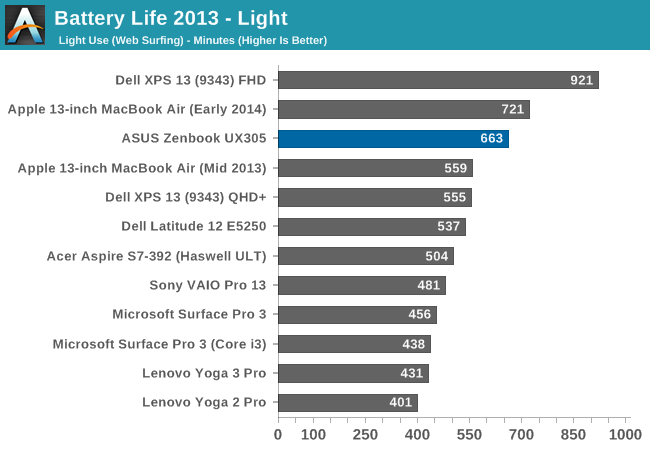
ASUS has packed tremendous battery life into this tiny fanless laptop. At just over 11 hours, it is one of the best results we have seen from any device, and it is all done on just a 45 Wh battery. It is not quite as efficient as the Dell XPS 13, despite the Dell having a 15 watt CPU, but the CPU is just a small part of this test, as it is generally not under much load. To see how the device fares under a heavier load, we will take a look at our Heavy test next.
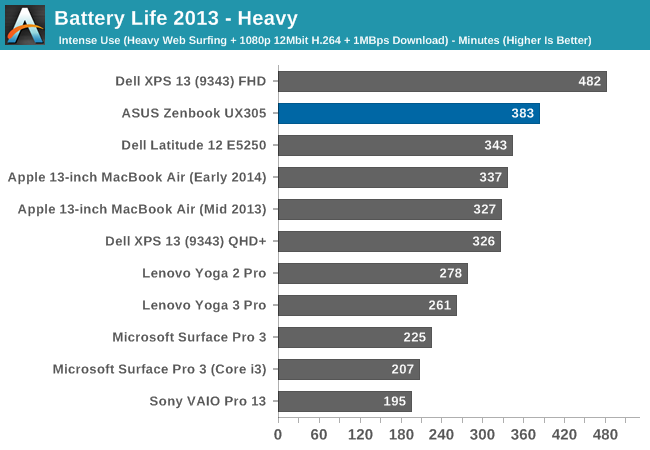
Once again the ASUS performs very well. Despite the thin design, the UX305 has plenty of battery life to handle most workloads with ease. Once more it doesn't quite measure up to the XPS 13, but that device also has a larger battery. To compare all of our devices for energy efficiency with the battery size removed from the equation, we have our normalized graphs.
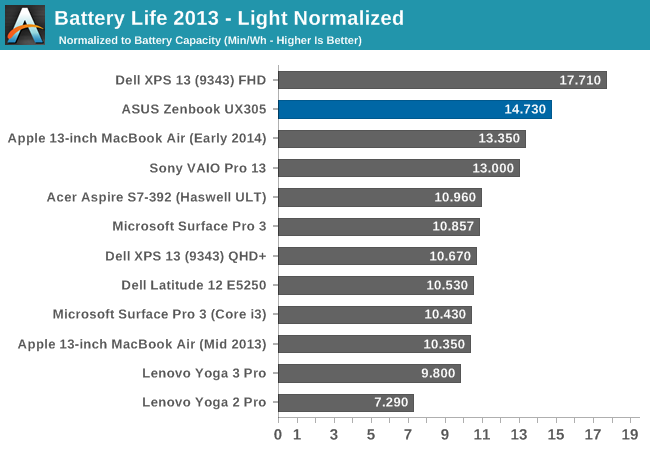
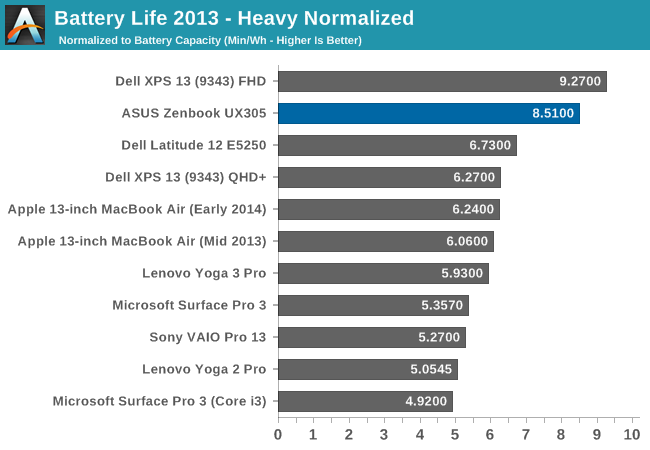
ASUS has done a great job on the overall platform efficiency of the UX305. While not quite class leading, it is quite a bit higher than most devices on the market. With just a 45 Wh battery, the UX305 does an outstanding job.
Charge Time
The other factor in mobility is charge time. Long battery life is great, but if you can top up quickly it can really extend the range of a notebook. The UX305 comes with a 45 watt charger, which seems to be fairly typical these days. There is certainly a trade-off to be made between charging speed and portability, because no one wants to bring a 3 lb charger along with a 2.6 lb notebook.
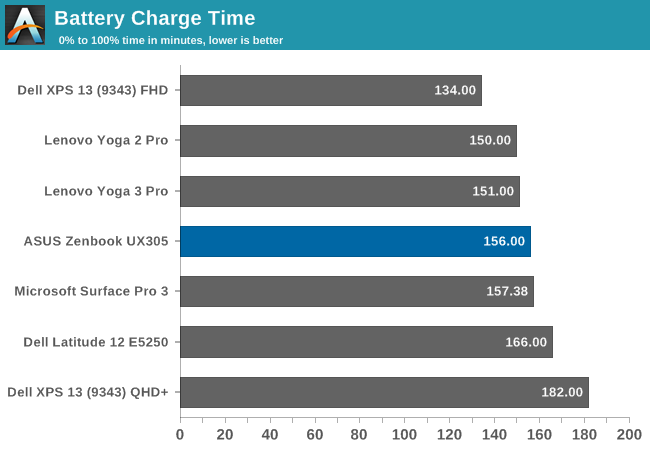
At 156 minutes, the UX305 falls right in line with most devices. Although there is little stopping someone from providing a faster charging rate, it seems most OEMs have settled on at or around this score as a target.
The UX305 charges very consistently, with it only leveling out well after 80% charge.
ASUS would be able to improve these scores with a higher wattage charger, but as compared to its peers it is about the same.
Wi-Fi Performance
ASUS has outfitted the UX305 that we have in for review with the Intel Dual Band Wireless-N 7265 wireless networking chip (not to be confused with the Wireless-AC 7265), which also includes Bluetooth 4.0 support. The change from the 7260 adapter seen predominately last year is a drop in power consumption. With a 2x2:2 design, the 7265 can connect at a maximum of 300 Mbps on 5 GHz. ASUS will be offering an 802.11ac card in the higher priced version of the UX305 which comes with the 3200x1800 display.
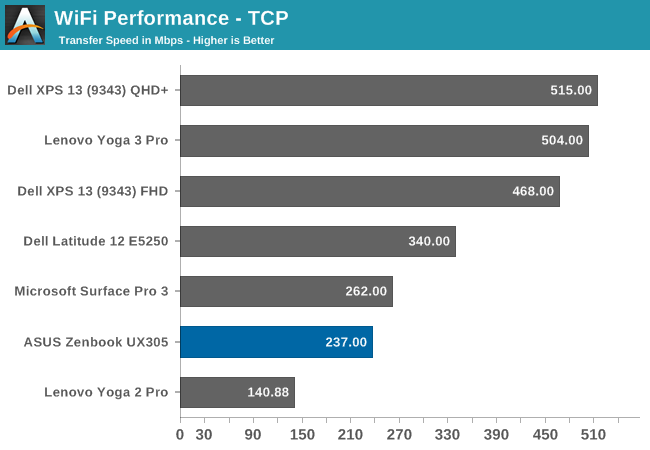
With just 300 Mbps maximum connection speed, the UX305 is sorely outclassed by devices which offer 802.11ac. ASUS is good enough to include a USB 3.0 Ethernet adapter though, for those that require more speed. Using the adapter, I was able to achieve 902 Mpbs transfer rates on our Wi-Fi benchmark. Frankly, I do appreciate the offer, but the money spent on the adapter could have just been used to give the UX305 802.11ac across the board, rather than just on the higher priced model. It is trivial for people to purchase a USB 3.0 Ethernet adapter if they need it, and plug it in, but replacing the Wireless card inside one of today’s laptops is a lot more challenging. This, like the display which raises the laptop, is one decision I have to question about the UX305.
Speakers
In their press materials ASUS has made a big deal about the engineering effort put into the speakers in the UX305, which were developed by the Golden Ear team at ASUS. As stated earlier, the UX305 sports two downward firing speakers, housed in 1.7 cubic centimeter chambers. The speaker dimensions are 25 x 9 x 3 mm and include a “high-intensity” coil. They also include some equalizer software to assist the user in setting the equalizer for various modes, such as VoIP calls, or music.
The audio solution is provided by Conexant and is a 2075x variant, so it should have around 2.8 watts of output power split between the two channels.
All of this being said, playing music I was only able to achieve around 76 dB (A weighted) which is about typical for this type of thin and light device. The outlier here is the Dell XPS 13 which manages 86 dB on the same music track. 10 dB means that the Dell is twice as loud.
However maximum volume is only one side of the equation. We will take a look at the frequency response of the speaker design next.
As you can see from the graph, there is little in the way of low end response, which I suppose is not unexpected for such small speakers. There is really not much in the way of audio response at all until after 200 Hz. There is also a big dip right at 1500 Hz. Overall, these are not the greatest speakers, but they should be fine for watching a few videos. Headphones would be needed for anything where you want to hear the full audio range though.


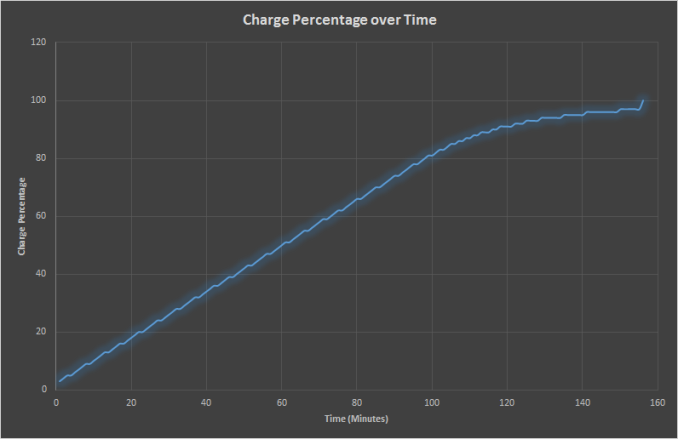
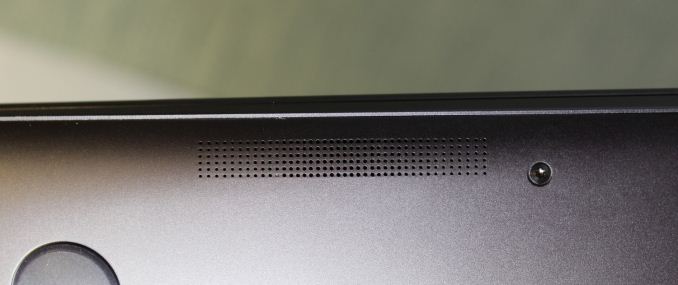
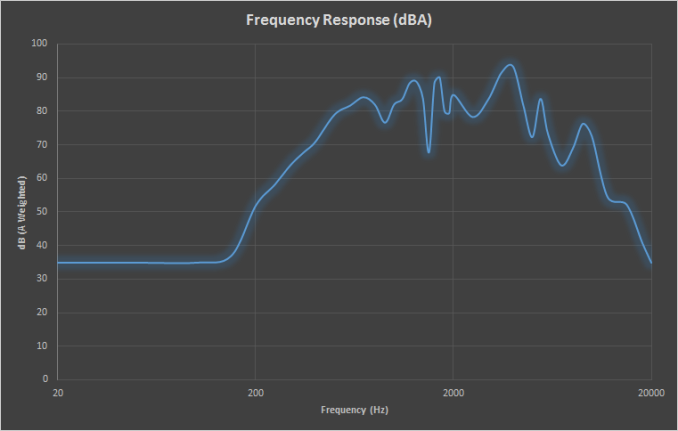








164 Comments
View All Comments
Klug4Pres - Wednesday, March 25, 2015 - link
I don't know why people want to buy these thin & light machines. What is wrong with a 5 lb laptop with a 35 Watt CPU, four RAM slots, two spindles, 14.1 inch 4:3 SXGA+ screen etc.? I keep being told "the ship has sailed", but I have no idea why.Novacius - Wednesday, March 25, 2015 - link
If you're traveling a lot or just have to take your laptop with you every day, you appreciate a lighter laptop. Very, very much. They also have much better battery life.Ian Cutress - Wednesday, March 25, 2015 - link
I used to carry a 4kg laptop with extended battery, 1200p screen etc to events like Computex and day trips/meetings for a couple of years. Put it this way, I'm glad I have a UX301 now at just over 2lbs. That being said, there are a few lighter weight systems that have me interested, like the LaVie Z that we saw at CES.Refuge - Wednesday, March 25, 2015 - link
I am the definition of a desktop replacement buyer.But even I see the relief in pulling out a 2lb feather on an airplane rather than some 17in 7lb beast.
Although those days are even coming to an end. Now you want a desktop replacement, the new Gigabyte P35X is a perfect idea! Thin, light, and TONS of horsepower. :)
Flunk - Wednesday, March 25, 2015 - link
If you want light and power I'd recommend getting a desktop AND a thin and light notebook. Why? The compromises necessary for thin and light notebooks are not compatible with the idea of a powerful notebook. Because of this you have to make a lot of compromises when it comes to heat, battery life, performance, price. At some point it might be possible but you can't get the best of both worlds right now.killeak - Wednesday, March 25, 2015 - link
Well, I disagree. As a render programmer that travels and works remote a lot (once every two months as minimum) I need a powerful laptop to work with. And the true is that these days there is plenty of great options that give you both (portability and performance). Recently I bought a Clevo p650sg (i7 4720hq, 980m, 32gb RAM, 2xSSD 500 + HD 1tb) for 2k usd. That being said, I do have a modern desktop PC at home that I bought last year (i7 4790, 16gb RAM, 500gb SSD + 2tb storage and a GeForce 770), but I prefer to use my laptop (I also bring it to the office and I plug to monitors and keyboard to increase my productivity). Performance wise, I will say that there is not much difference between my new laptop and the desktop that I use, in fact my new laptop is more powerful than my desktop at work except for the CPU (4770, 16gb RAM, 256 SSD and geforce 760).I love to have the performance of a powerful desktop in 2.6kg (before I had a Lenovo Y500, not that powerful but close and same weight). These days I use my desktop pc at home more as a media server and some occasional gaming on the TV than for work or main gaming platform (in any case I play SC2 and Civ5 mostly and I can play those on my laptop, even my old one).
That being said, I do see the point of ultrabook or hybrids. I also have an Asus T100 that I use as my true mobile laptop/tablet that I bring with me everywhere. For web surfing, mails, word/excel, watching movies/series at the airport/airplane, etc. is great, and battery life is awesome. I see myself buying a Surface Pro 4 or something like it in the future, to replace the T100, but not for actual work since I need a true i7 (not ULV), lot of ram and a powerful GPU, that I can bring with me when I travel.
Refuge - Wednesday, March 25, 2015 - link
I disagree, but only half.While you are correct and if you want power then there is no better solution than a full fledged desktop.
But you can't say that Laptops can't be defined as powerful when it is toting a 4ghz I7 with a GTX 980m. That is like saying a Corvette isn't sports car because it isn't a Ferrari. Laughable I know right?
Either way, broad stroke generalizations like that are quickly falling apart with each passing year as they cram more and more power into smaller and smaller packages. Anymore you are really only lacking in personal upradability. Which I can see being a big enough problem to turn people towards a desktop form factor of some sort.
andrewaggb - Wednesday, March 25, 2015 - link
I mostly agree, I've done the 17" laptop with dedicated graphics. It quickly lost it's ability to play the latest games with high settings, and eventually do play the latest with reasonable settings. It's battery life sucks, it's heavy, it's useless on an airplane, etc.It was handy for gaming on vacation though. I've been tempted to buy 2 new laptop's, another gaming/big screen 17" laptop and a 12 or 13" ultralight. They're both laptops, but they serve completely different purposes.
Conficio - Wednesday, March 25, 2015 - link
Working with two machines brings a lot of hassles of its own. Installing apps twice, upgrading twice, synching data, etc. having more storage on the desktop means you have to be selective and then you go the wrong selection on the road.I'd wish I could have an OS that has a seamless cloud extended storage, synching apps and documents a I need. Did I describe ChromeOS here?
kingpotnoodle - Wednesday, March 25, 2015 - link
Because (very obviously) if you don't need a powerful machine but you do a lot of travelling then it's much better to have a lighter machine with a long battery life. Most of my work is web/ssh/rdp, long battery life and lighter weight are FAR more important to me than it being able to play Crysis or do video editing lightning fast.